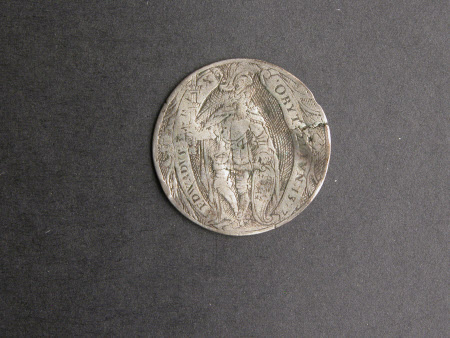Token or counter commemorating King Edward III
probably Van der Passe workshop (active c. 1580-1670)
Category
Coins and medals
Date
circa 1630 - 1635
Materials
Silver
Measurements
264 mm (Diameter)
Place of origin
London
Order this imageCollection
Osterley Park and House, London
NT 773242
Summary
Silver, Token or counter commemorating King Edward III, cast London or Antwerp, possibly Van der Passe workshop (active c. 1580-1670), c. 1630-35. An engraved silver token or counter commemorating Edward III (1312-1377) and his reign, from a set of thirty-six made c. 1630-35, probably in the workshop of the Van der Passe dynasty, perhaps by Willem van der Passe (c. 1598- c. 1636). Obverse has standing figure of the king, with sword in right hand, the two crowns of England and France threaded onto the blade. With left hand supports shield standing on ground, emblazoned with the royal arms. Inscription reads ‘Edward III King, died 21 June 1377.’ On the reverse the royal coat-of-arms and an inscription reading ‘Reigned [50] years, buried at Westminster.’ The token is bent and the surface worn.
Full description
Edward III (1312-77) was the son of Edward II and Isabella of France. He became king whilst still just a teenager, in 1327, after his father had been deposed by his mother and her lover, Roger Mortimer. Isabella ruled with Roger in Edward's name until 1330, when he executed Mortimer and banished his mother. In 1328 Edward married Philippa of Hainault. Edward was a warlike monarch both at home, warring with the Scots, and abroad. In 1340 he assumed for himself the title of King of France, unleashing the Hundred Years War between England and France. Together with his son Edward, the Black Prince, Edward IIII won a series of stunning victories against French forces, notably the battles of Crécy (1346) and Poitiers (1356), and the capture of Calais, which henceforth became the English bridgehead to France. The Treaty of Bretigny in 1360 saw Edward renouncing his claim to the French throne, in return for sovereignty over the province of Aquitaine; however, only nine years later the French declared war again and, by the time of Edward’s death in 1377, the English gains in France were already unravelling. In 1348 Edward founded the highest order of British chivalry, the Order of the Garter. The engraved token depicts Edward as a martial figure dressed in armour. It is from a series of 36 standing Sovereigns of England, probably made in the van der Passe workshop, perhaps by Willem van der Passe (c. 1598-c. 1637), one of the sons of Crispijn van de Passe the Elder (c. 1564-1637), a Dutch publisher and engraver, who worked in Antwerp. Crispijn’s son Simon on the other hand worked in England from c.1616 to 1624 when he left to work in Copenhagen, his younger brother Willem taking his place in London. There are two known sets of these engraved counters of the English sovereigns from the van der Passe workshop or circle; in one, to which the Edward III belongs, the monarchs are shown standing, in the other they are presented at half-length (Mitchiner, Jetons, Medalets and Tokens, III, pp. 1675-78, no. 5). Both series were issued in boxed sets of 36. The full-length series begins with Edward I and finishes with Charles, Prince of Wales, the future Charles II, whose birth in 1630 provides a terminus post quem dating for the series. The half-length series finishes with Prince James, the future James II/VII, born in 1633. There has been much debate as to whether these small silver plaques could have been individually engraved, which was long thought to be the case. However, technical examination of gold and silver examples of the medal of Queen Elizabeth I demonstrated that whereas the gold version was clearly engraved by hand, the silver had been cast, as were other examples of the plaques in silver (Mark Jones, ‘The technique of Simon van de Passe reconsidered’, The Numismatic Chronicle, Vol. 143 (1983), pp. 227-230). As designs, the images of monarchs have many parallels with a popular series of engraved portraits of English rulers from 1066 until 1584, designed and engraved by Hendrick Goltzius, and published in 1585 in Antwerp, where the van de Passe family was largely based and active. These prints were widely copied until well into the seventeenth century. The half-length series may also be compared with the engravings by Renold Elstrack of monarchs, in the highly successful anthology Baziliologia, A Booke of Kings, being the true and lively effigies of all our English kings from the Conquest untill this present, published in London in 1618. Jeremy Warren 2019
Provenance
Given to the National Trust in 1993 by George Child Villiers, 9th Earl of Jersey (1910-1998).
Marks and inscriptions
Obverse, legend: EDWARDVS. 3. REX/OBYT 21: IVN: 1377 Reverse, legend: RAINED 50 YEARS. BVRIED AT WESTMINSTER. Reverse, legend on garter: HONI SOIT QVI MAL Y PEN[SE]
Makers and roles
probably Van der Passe workshop (active c. 1580-1670), designer
References
Hawkins, Franks and Grueber 1885: Edward Hawkins, Augustus W. Franks and Herbert A. Grueber (eds.), Medallic Illustrations of the History of Great Britain and Ireland to the death of George II, 2 vols., London 1885, vol. I, pp. xiii-xiv. Farquhar 1916: Helen Farquhar, ‘Silver Counters of the Seventeenth Century', The Numismatic Chronicle, Fourth Series, Vol. 16 (1916), pp. 133-193, esp. pp. 170-74, no. 4. Mitchiner 1988-2007: Michael Mitchiner, Jetons, Medalets and Tokens, 4 vols., London 1988-2007, III (British Isles circa 1588 to 1830), 1998, pp. 1667-70, no. 4.13 (4823).
